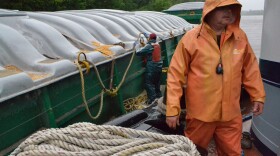The Lois McClure is a replica of an 1862 canal schooner that's also a floating museum. This summer she's commemorating 19th century transportation history by traveling from Lake Champlain, across the canal system to Buffalo, down the St. Lawrence river to Montreal, and back again.
First mate Tom Larsen is a strapping guy with a long ponytail and glasses. He’s pulling hand-over-hand on a thick white rope, getting the Lois McClure onto the lake for the first step of a four-month voyage. "Hauling out, to a mooring, Tom explains, breathing heavily, "then we’ll have the tug boat come along side us where it’s deep enough water."
We’re being towed by a tug boat right now. Once the boat’s reaches Lake Ontario, the crew will put up to the sails. But for now, we chug across the lake to Westport, where Larry Caroll, who owns the local marina, pumps out the boat's holding tank.
"I remember when they were raising funds for this boat," Larry says. "I’ve had the tour a few times on it and because of the tour we actually named our cats off of some of the parts of the Lois McClure. We had one named fo’c’sle, windlass, you know boat parts."
After pumping out the holding tank, we head south.
Art Cohn, co-founder of the Lake Champlain Maritime Museum, explains that canal schooners like the Lois McClure were basically the 18 wheelers of their day.
"These boats were blue collar, work-a-day trucks from their generation."
Canal schooners could sail on the lake and take down their rigging to travel through the canal systems.
They carried lumber, coal, and stone. They’d even bring agricultural products like hay and apples down to New York City.
But the railroad industry put a lot of boats out of business.
By the 1920s, canal schooners were mostly obsolete – and their history was forgotten.
But then museum divers found a canal schooner wreck on the bottom of Lake Champlain. They decided to build a replica – and take it on tour.
"As a historian, as someone who wants people to engage in their history, the boat was magical in that it provoked that, Art Cohn explains. "You walked on board, you were interested, you wanted to know."
Crew member Len Ruth says working on the boat makes that history seem very real.
"Just feeling what it was like for the people who lived on these boats and a really good way to do that is actually to live on board and do things the way they did as much as you can."
All summer, the crew has to live together and work together in a pretty small space.
Down below, Kerry Battdorf, the ship’s carpenter, is on his hands and knees in the ship’s head – the nautical word for bathroom.
"I’m trying to fix a pump right now – the sump pump for the basin in the head. All it does is drains out of the sink and into the holding tank. Looks like there’s a bunch of hair wrapped around the shaft of the pump."
"Gross," I say.
"Somewhat," he replies.
In the galley, Kathleen Carney is getting dinner ready.
"We’re cooking dinner which tonight is going to be salmon grilled by Tom, and premade potato and egg salad, and asparagus."
The boat’s refrigerator is battery-powered and disguised to look like a red cargo crate. Kathleen only has a two-burner stove. But she still pulls together amazing meals for the crew.
"We always have a ham on hand, I call it the emergency ham, in case something goes wrong or we don’t have to get to go shopping."
When the boat docks, Kathleen gets a ride to the grocery store and stocks up for the next week. She keeps a lot of canned food around, just in case.
"We’d never starve, but it might get boring."
We dock at Crown Point and eat dinner. It’s delicious. Just before bedtime, the rain starts, and the boat rocks softly as we fall asleep.
***
Boat captain Roger Taylor leads the morning meeting.
"Conditions are good for RDF, radio direction finder or rain, drizzle, and fog. We’ll go slowly and carefully as always. No one is allowed to fall overboard under any circumstances."
Today we're heading to Whitehall. It’s pouring rain – but nobody’s really complaining.
Up on deck, Len’s wearing waders and a rain coat. His hood is pulled all the way down over his glasses. He says canal boat sailors from 1860s probably had rain like this, too.
"They would’ve had to put up with it when it happened just as we do, so in a way we are real mariners."
We chug south, to the Champlain Canal.
It’s a narrow passage with high concrete walls. The water slowly rises beneath us – and the yellow gates swing open.
"You guys can go out ahead of us," Roger says over the walkie-talkie, "and then once we get out of the lock and start over to the dock you can make up on the port bow."
We tie up outside the Skenesborough Museum in Whitehall. The crew gets ready for visitors, who will learn about a journey not too different than this one.







